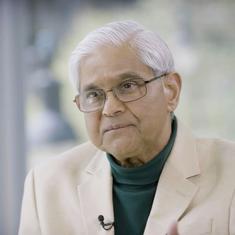Sometime in the 1980s, I had the great pleasure of meeting Shashi Kapoor for the first time at a film festival, and like millions of others, was struck by his utter charm, his winning smile and his natural ease. He was warm and personable, and even though he knew full well that everyone around him instantly knew who he was, with a glint in his eye, he would extend his hand for a handshake and say, “I’m Shashi Kapoor.”
Some years later, I asked him if he’d agree to be interviewed for the TV series, Movie Mahal, that I was making for Channel 4 TV, UK. The series aimed to document the history of Hindi cinema and consequently we had interviewed many leading film practitioners. I explained to Shashiji that we’d like to talk to him about film music and the 1950s. And although he was extremely busy, he agreed with no fuss at all and said he’d give us time between takes at Film City.
Shamefully, I do not remember the name of the film that he was shooting, but I know that when our camera was rolling, he gave us his complete attention. Our interview took place on April 25, 1987, and to think 30 years later he is no longer with us. It feels like we’ve lost one of our own.
Shashi Kapoor: Why are the songs of the 1950s more popular than today’s songs? I think it is a very simple answer. In the ’50s, we made lovely films. We made films with some beautiful social themes, beautiful romantic films. They all had music, of course.
Mughal-e-Azam, one of our biggest films ever made, started production in the ’50s. These films took some time, they weren’t a rushed job, there weren’t so many films being made then. We weren’t making 930 films a year in the ’50s. So the music directors weren’t burdened by too many productions – they had time to concentrate, plus they had material. They had scenes and situations, which demanded beautiful melodies, and so beautiful melodies were created.
In today’s times with violence dominating the scene, you can only have disco music you know, or loud bangs or timpani just going crazy, but you can’t have melodies, and that’s a shame, because there are too many films being made, and too many violent films being made. So you have disco and synthesizer.
Nasreen Munni Kabir: How did you feel about performing the song sequences?
Shashi Kapoor: In the early days when I started in the 1960s – although I was acting in the 50s, but as a child artist –I loved it. I thought it was terrific. It was a pleasure to sing the songs of Mohammad Rafi and Mukesh, and the 1960s composers like Kalyanji-Anandji, Shankar-Jaikishan, SD Burman, Madan Mohan and Laxmikant-Pyarelal.
It was also a pleasure to work in romantic films that had hardly any violence. I did a film with Laxmikant-Pyarelal called Pyar Kiye Ja, which was a straightforward farce. We were five major stars who were playing comedy roles. There was no villain – there were no fights. But there were lots and lots of songs and dances, and it was great. I loved it, you know.
And doing all these Busby Berkeley numbers – on the stage, in the train, on the train, on the ship, in the boat, on the plane and hanging from the helicopters – things like that.
Nasreen Munni Kabir: I wanted to ask about the playback singers. How would you define Geeta Dutt’s style?
Shashi Kapoor: Oh, I think Geeta Dutt was a little before my time. Not exactly, I mean she was still there in the ’60s when I joined in, because there is a film I was supposed to do for her husband, but then I was kind of sacked, I don’t know why. I still don’t know why, and he did the role himself [the reference is to Guru Dutt in Bhootnath’s role]. It was called Sahib Bibi Aur Ghulam. It had excellent music, and Geeta Dutt was excellent. She sang for Meena Kumari, and she sang for Waheeda Rehman. I think she had a very unique kind of voice.
There were lots of numbers — my sister-in-law, Geeta Bali, was alive then and she did lots of numbers with Geeta Dutt singing for her. It is very sad that we lost both of them.
Nasreen Munni Kabir: What would you say is the main difference between working in the West and here?
Shashi Kapoor: Not much of a difference except that the equipment is much better there. For example, you have Panavision there, and we don’t get Panavision here. And then we don’t make those kinds of expensive films.
Though I am going to make a film this time – but the budgets are pretty low, so you cannot afford to have fancy equipment. Or lots and lots of people working on the film – very few budgets in India can afford that. But the making is the same, the acting is the same, the shot-divisions are always the same. Great fun.










